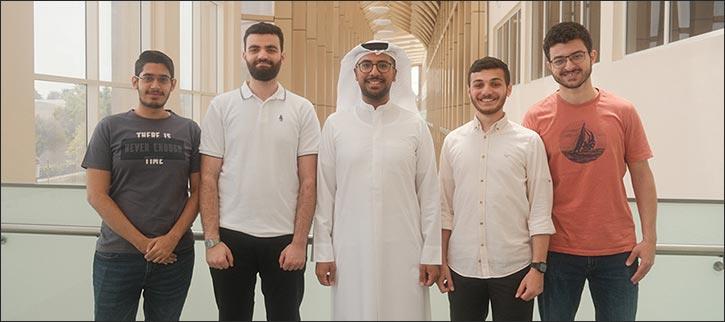Their project Shaheen gives drones the ability to detect people in the desert and send their precise location to search and rescue teams
Sharjah, UAE, September 22nd, 2025— When someone goes missing in the desert, every minute can mean the difference between life and death. That urgency inspired a group of American University of Sharjah (AUS) students to develop Shaheen, a senior design project that equips drones with the ability to spot lost individuals and alert rescuers in real time. Their innovation has just earned second place at Dell Technologies' 2024-2025 Envision the Future competition, which attracted 259 projects from 14 countries across the Middle East, Turkey and Africa.
The name Shaheen comes from the falcon admired in the UAE for its speed, sharp vision and precision. Just as the falcon is able to spot its target from great distances, the device, when attached to a drone, can scan wide stretches of desert with accuracy and agility, giving rescuers precious time when lives are at risk.
Shaheen was developed by computer engineering students Yousef Irshaid, Malik Hader and Adham Elmosalamy along with computer science student Ahmad Alsaleh, under the supervision of Dr. Mohamed Alhajri, Assistant Professor of Computer Science and Engineering. Their work Shaheen was recognized in May 2025, when the AUS Department of Computer Science and Engineering (computer engineering program) awarded the project first place in its Senior Design Projects competition for the Academic Year 2024-2025.
'Shaheen reflects the best of what our students can achieve when they combine innovation with purpose,' said Dr. Alhajri. 'They took on a complex challenge and created a system that is efficient, practical and capable of operating under the harshest conditions. Their work shows how education and creativity can come together to serve society and reflects the UAE's national vision of placing innovation and technology at the center of growth and global leadership.'
When the team first began their project, they discovered that no suitable database of desert images existed to train their system. Instead of stopping there, they built one themselves—the largest desert search-and-rescue image collection in the region. With the help of a drone pilot, they captured more than 7,500 real images from UAE deserts, varying clothing, poses and movements so the system could recognize people in many different situations. To strengthen their training further, they created over 90,000 additional images using computer simulations. Together, this massive dataset gave Shaheen the knowledge it needed to detect people with remarkable accuracy.
'At first, the system missed many detections and it was frustrating,' said Irshaid. 'But after expanding our image collection and testing different models, we finally reached 98 percent accuracy. That was the breakthrough moment.' Hader recalled, 'It was then we realized our idea could move from being a class project to something that could actually save lives.'
The device itself was carefully engineered to be small, lightweight and energy-efficient. Housed in a compact 3D-printed case that can be attached to a drone without weighing it down, Shaheen uses less than one watt of power. To ensure images and coordinates reach rescue teams quickly, the students also developed a new transmission method that allows data to be sent reliably even under tough desert conditions, something that can make the difference between life and death in an emergency.
Before sending Shaheen into the field, the students put it through extensive lab testing to confirm its accuracy and efficiency. They then conducted real desert trials, where the system faced extreme heat, rough terrain and the constant challenge of keeping drones in the air.
'It pushed us to be patient and creative,' said Elmosalamy. 'We had to learn teamwork and problem-solving in real time.' For Alsaleh, the project's goal was always the strongest motivator. 'Every minute matters in a rescue,' he said. 'Knowing that Shaheen could help bring someone home safely kept us going through the hardest days.'
The students now plan to improve Shaheen's design by making it more durable and even more suitable for desert conditions. They are also preparing to share their dataset and methods so others can build on their work. The next stage will involve full desert flight trials of the fully integrated system.
'Our hope is for Shaheen to become a trusted tool for search and rescue teams across the UAE,' said Hader, 'and eventually to support efforts in other countries with similar environments.'
While Shaheen has drawn international attention, it represents the wider spirit of innovation at AUS, where students and faculty work together to tackle real-world challenges. The university's curriculum is designed to give students the knowledge, creativity and hands-on experience they need to transform technology into solutions that improve lives far beyond the classroom.
Posted by : DubaiPRNetwork Editorial Team Viewed 283 times
PR Category : Education & Learning
Posted on : Monday, September 22, 2025 10:40:00 AM UAE local time (GMT+4)
|
| Next Story : Brighton College Dubai Pupils Achieve Record GCSE Success wi... | |
|
|
| |
| |























Comments
No comment